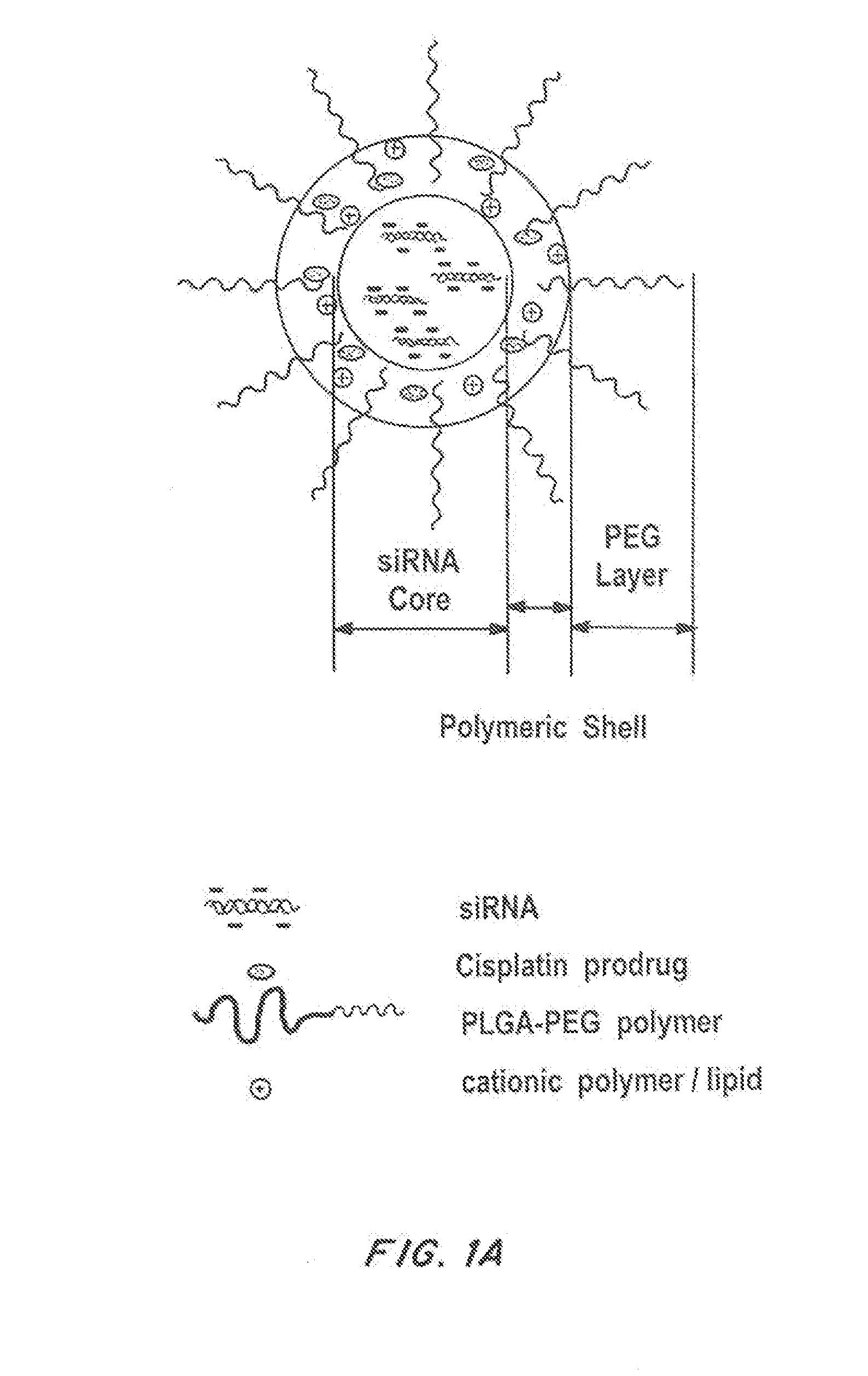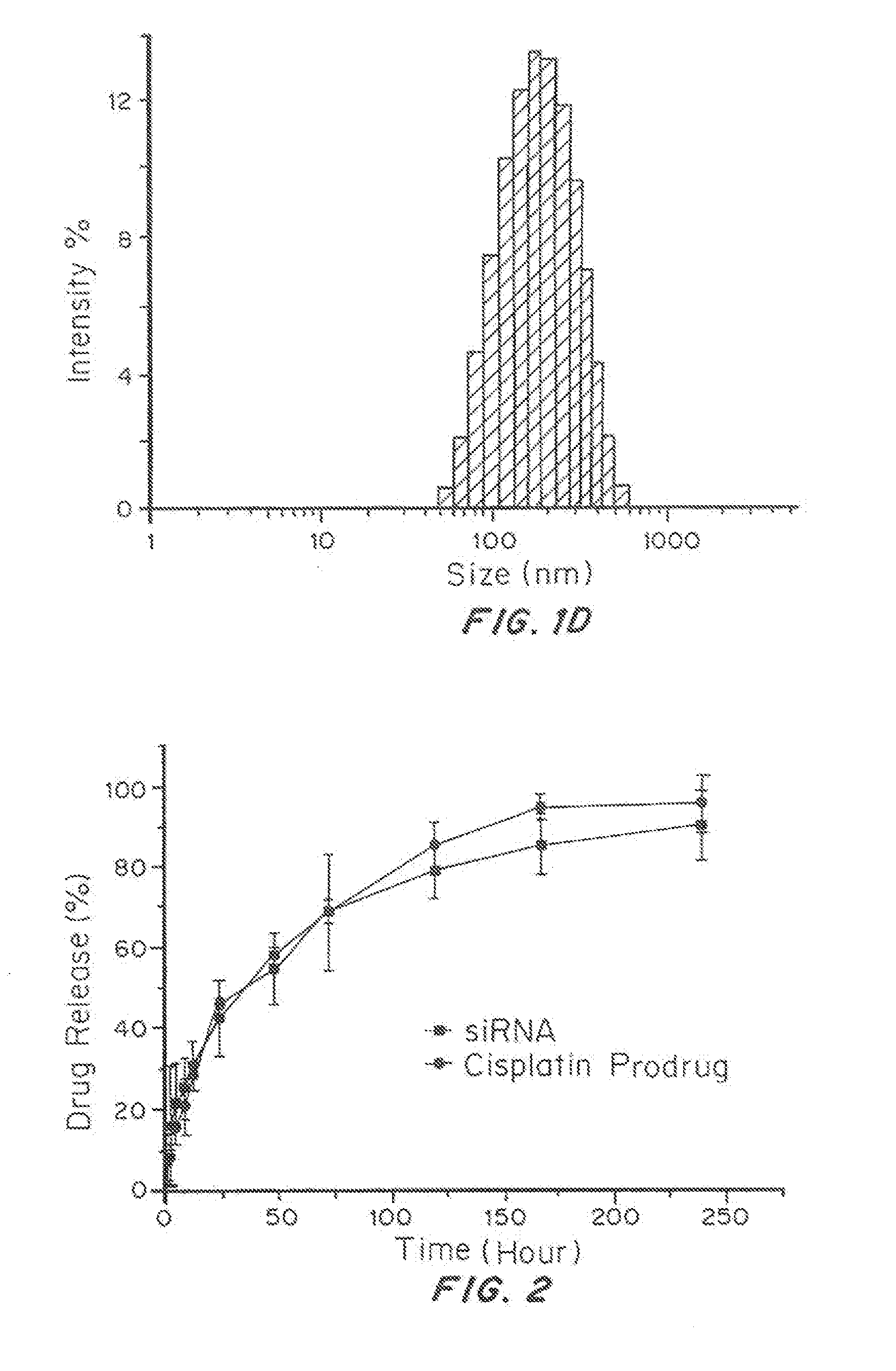Cationic nanoparticles for co-delivery of nucleic acids and therapeutic agents
a technology of nucleic acids and nanoparticles, applied in the field of nanoparticles, can solve the problems of drug resistance and tumor recurrence, phenotypically distinct and possibly more virulent tumors, and is susceptible to degradation, so as to prolong the circulation of particles in the blood stream, promote the retention of sirna molecule, and control the effect of drug releas
- Summary
- Abstract
- Description
- Claims
- Application Information
AI Technical Summary
Benefits of technology
Problems solved by technology
Method used
Image
Examples
example 1
Synthesis of Hydrophobic Cationic Component (G0-C14)
[0161]G-C14 was synthesized by reacting 1,2-epoxytetradecane with generation 0 of ethylenediamine core-PAMAM dendrimer according to a known procedure. In order to increase the proportion of products with one less tail than the total possible for a given amine monomer, a substoichiometric amount of 1,2-epoxytetradecane was added to PAMAM dendrimer at a molar ratio of 7:1. The mixture was reacted under vigorous stirring at 90° C. for 2 days. The crude reaction mixture was separated by chromatography on silica with a gradient elution from CH2Cl2 to 75:22:3 CH2Cl2 / MeOH / NH4OH. The purified product was characterized by 1H NMR.
[0162]The design and preparation of polymer / G0-C14 hybrid NPs are shown in FIGS. 1A-C. To facilitate siRNA encapsulation, cationic lipid-like molecules termed G0-C14 was synthesized through ring-opening of 1,2-epoxytetradecane by generation 0 of poly(amidoamine) (PAMAM) dendrimers (FIG. 1C). NPs were prepared throug...
example 2
Synthesis of cis,cis,trans-[Pt(NH3)2Cl2(OOC(CH2)8CH3)2]
(Compound 1)
[0163]Decanoic anhydride (0.41 g, 1.26 mmol, 3.8 equiv) was added to a solution of cis,cis,trans-[Pt(NH3)2Cl2(OH)2] (0.11 g, 0.33 mmol) in 10 mL DMF and the mixture was then stirred at 55° C. After 16 h, unreacted cis,cis,trans-[Pt(NH3)2Cl2(OH)2] was removed by the filtration, and the resulting yellow solution was then reduced to 3 mL under reduced pressure. This concentrated solution was then added drop-wise to a rapidly stirring volume of diethyl ether (50 ml) forming a pale yellow precipitate. The buff-colored powder was filtered and washed twice with 30 mL of diethylether. The final product was dried in a desiccator. Pale yellow solid. Yield: 65% (0.138 g, 0.21 mmol). ESI-MS m / z calculated (M-H)−: 641.2, found: 641.1. 1H NMR (DMSO-d6): δ0.85 (t, 6H, J=8.8 Hz), 1.22 (m 24H), 1.44 (q, 4H, J=8.2 Hz), 2.19 (t, 4H, J=8 Hz), 6.53 (s, 6H). 13C NMR (DMSO-d6): δ 14.15, 22.11, 25.37, 28.66, 28.97, 31.47, 35.86, 180.02. 195...
example 3
Preparation and Characterization of NPs Containing siRNAs and Compound 1
[0165]Materials and Methods
[0166]Copolymer PLGA-b-PEG was synthesized by the amide coupling of HOOC-PEG-NH2 to PLGA-COOH in methylene chloride as previously described. The NPs encapsulated with a combination payload of siRNAs and compound 1 was formulated via double emulsion solvent evaporation technique. In brief, copolymer PLGA-b-PEG and G0-C14 were co-dissolved in dichloromethane (DCM) with or without compound 1. siRNAs was reconstituted in HyPure™ molecular biology grade water (Hyclone Laboratories, Inc., Logan, Utah). The siRNA solution (0.4 mL) was added drop-wise into 1 mL PLGA-b-PEG and G0-C14 solution and emulsified by probe sonification to form the first emulsion. Next, the emulsified mixture was added into 3 mL aqueous solution containing 1% PVA, followed by probe sonification to form the double emulsion. The final emulsion solution was poured into 15 mL water and stirred for 3 hours to allow the DCM ...
PUM
| Property | Measurement | Unit |
|---|---|---|
| diameter | aaaaa | aaaaa |
| concentration | aaaaa | aaaaa |
| concentration | aaaaa | aaaaa |
Abstract
Description
Claims
Application Information
 Login to View More
Login to View More - R&D
- Intellectual Property
- Life Sciences
- Materials
- Tech Scout
- Unparalleled Data Quality
- Higher Quality Content
- 60% Fewer Hallucinations
Browse by: Latest US Patents, China's latest patents, Technical Efficacy Thesaurus, Application Domain, Technology Topic, Popular Technical Reports.
© 2025 PatSnap. All rights reserved.Legal|Privacy policy|Modern Slavery Act Transparency Statement|Sitemap|About US| Contact US: help@patsnap.com



